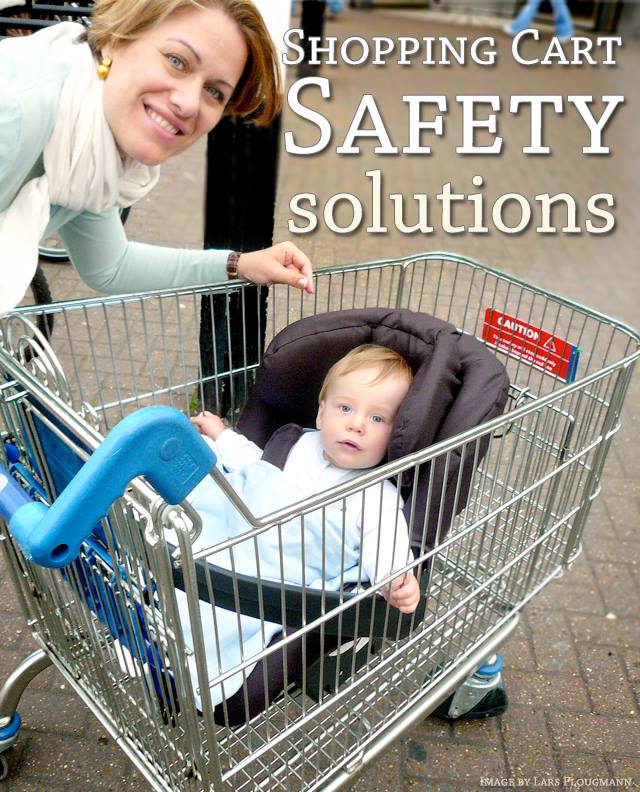How to Keep Your Child Safe in the Shopping Cart
Shopping cart injuries happen to more babies and children than you’d probably think. Here we’re covering how to make sure your child is safe and secure in the shopping cart.
 Many of us have seen parents set an infant carrier or car seat – baby in tow – on top of the shopping cart.
Many of us have seen parents set an infant carrier or car seat – baby in tow – on top of the shopping cart.
The temptation is understandable.
You’re in a rush to get the shopping done, and you need both hands free to maneuver the cart and grab the items on your grocery list. But if parents knew just how often the combination of kids and shopping carts resulted in serious injuries, they wouldn’t take the risk.
According to the Consumer Product Safety Commission (CPSC), shopping carts are the leading cause of head injuries in young children – surpassing injuries from high chairs, strollers, changing tables, baby gates and other equipment. The CPSC estimates that about 16,000 children under the age of five fall out of shopping carts each year and nearly 1,000 of those injuries involve falling infant carriers.
Infant carriers should not be placed on top of the cart
Infant carriers are simply not meant to be placed on top of the cart. When bumped or jostled, they can tip or fall out of the cart entirely, resulting in serious head trauma for the baby inside.
Some parents erroneously assume the latch on their infant carrier is meant to be used with shopping carts, but that’s not the case. There are more than 100 different types of carts used in the United States, and no carrier can fit them all properly. Plus, manufacturers of car seats and infant carriers even warn against using their products with shopping carts. Unfortunately, parents often don’t notice the warning stickers on car seats and shopping carts – even though they display a big, red “X” over the image of an infant carrier on the cart!
A fall from the cart isn’t the only risk; trying to force the carrier to fit onto a shopping cart can also damage the car seat’s latching mechanism, making it less effective in a car accident.
So, how can parents keep their kids safe? Some experts suggest leaving the baby at home while you shop, but that’s just not a realistic expectation for most families. Fortunately, it’s possible to bring the baby shopping and avoid cart injuries.
Wear Your Baby
The first solution is simply to wear your baby. There are many different types of carriers available, from the Asian-inspired mei tais to ring slings and wraps. Baby-wearing has its advantages: Your baby is physically close to you, and your arms are free to push the cart and reach for groceries. However, it’s essential to practice.
If you are not used to wearing your baby, it is important you find the carrier that is right for you and start by reading the manufacturer’s instructions. While many people love wraps and slings, they can sometimes make it difficult for parents to reach low shelves and lift heavy grocery items. If you find baby-wearing causes lower back problems or makes it difficult to carry a handbag, you might try another option for shopping trips.
Consider a Safe Dock
Another safe solution involves a new cart attachment called Safe-Dock, which is being used in a growing number of stores nationwide. Safe-Dock is the first universal infant carrier docking station for shopping carts. It is permanently mounted to the top basket of the shopping cart, with a heavy-duty harness that buckles in the infant carrier as easily as a seat belt. Many parents like this option because the baby is facing them, allowing for parent-baby interaction – without “baby weight” limiting their mobility. And because the infant isn’t sitting directly on the cart, it is more sanitary than previous in-store infant carriers. Like baby-wearing, it also conserves space in the main part of the shopping cart, so you can actually use it for groceries.
Safe-Docks are currently used at major retailers across the country. You can find stores with Safe-Dock near you at shoppingcartsafety.com, where you can also learn more about this important safety issue.
Whatever your preference for getting baby around – and getting your errands done – it’s important to keep the number-one rule in mind: safety first!
Paul Giampavolo is a leading expert on shopping cart safety and is chairman of the American Society for Testing and Materials’ (ASTM) Shopping Cart Subcommittee. He is also president of The Safe-Strap Company, which has been committed to child safety since it invented the world’s first child safety seat belt for shopping carts in 1983.
